Seapost -> 1894 Paquebot marks
1894 Paquebot marks
in the beginning
By Mike Dovey
By 1891 the shipping lines from Europe were going all over the world and the passengers on board were having great difficulty in posting mail. A letter written on board ship could only be posted if and when the ship arrived at a port. Someone was sent ashore to purchase postage stamps, and then the letter was posted by the same person having to go ashore again to the post office. In 1892 the Universal Postal Union (UPU) decided at a meeting in Switzerland that all ships were their own sovereign territory while on the high seas and outside territorial waters and that a passenger could write a letter, add a stamp of the country to which the ship was registered, and put the letter in the ship's mailbox. From there it was taken to the nearest post office in the next port of call and a "paquebot" postmark was added to the letter, usually over the stamp.
 The first time vessels on the high seas were to use this method was in 1894. It was taken
up at first by Britain and France and then spread around the world because it was so much
easier to use this new postal system to send mail. From 1894 onwards the Post Office in
Great Britain issued a new rubber "paquebot" cancellation 33mm in length (Hosking 22)
to all post offices that needed such a mark. These included not only London but also Bristol,
Dartmouth, Dublin (Dublin & Cork TPO), Edinburgh, Folkestone, Grangemouth, Greenock, Grimsby,
Hull, Leith, Liverpool, Newcastle-upon-Tyne, Plymouth, Queenstown,
St. Helier, St. Peter Port,
South Shields, and Southampton. The mark was also sent abroad to certain post offices including
Port of Spain in Trinidad, Colombo in Ceylon, and Gibraltar.
The first time vessels on the high seas were to use this method was in 1894. It was taken
up at first by Britain and France and then spread around the world because it was so much
easier to use this new postal system to send mail. From 1894 onwards the Post Office in
Great Britain issued a new rubber "paquebot" cancellation 33mm in length (Hosking 22)
to all post offices that needed such a mark. These included not only London but also Bristol,
Dartmouth, Dublin (Dublin & Cork TPO), Edinburgh, Folkestone, Grangemouth, Greenock, Grimsby,
Hull, Leith, Liverpool, Newcastle-upon-Tyne, Plymouth, Queenstown,
St. Helier, St. Peter Port,
South Shields, and Southampton. The mark was also sent abroad to certain post offices including
Port of Spain in Trinidad, Colombo in Ceylon, and Gibraltar.

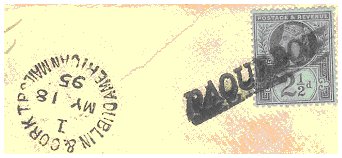 Initially the mark was to be used with purple ink and special inkpads were issued with an
ordinary purple ink. However, in many cases a post office would use the regular black ink issued
to them and this, being a very strong and indelible type of ink, would often soften the rubber
handstamp and cause the mark to spread until it became so distorted it was unusable. Therefore,
in many cases, the older the mark then the more unreadable it became. Letters dated pre 1900 are
quite rare and are sought after.
Initially the mark was to be used with purple ink and special inkpads were issued with an
ordinary purple ink. However, in many cases a post office would use the regular black ink issued
to them and this, being a very strong and indelible type of ink, would often soften the rubber
handstamp and cause the mark to spread until it became so distorted it was unusable. Therefore,
in many cases, the older the mark then the more unreadable it became. Letters dated pre 1900 are
quite rare and are sought after.
While the Post Office in Great Britain was issuing what was the first "omnibus" paquebot mark for use in their post offices, the French Post Office was also issuing their own "omnibus" cancellation. In this case it was a single line mark 22.5 mm long (Hosking 410) and was issued to post offices including Bordeaux, Boulogne, Granville, La Rochelle, Le Havre, Marseille, Port Vendres, and Toulon from 1894 onwards. The mark was also sent to a number of overseas post offices under French control.
PAQUEBOT applied at Le Havre
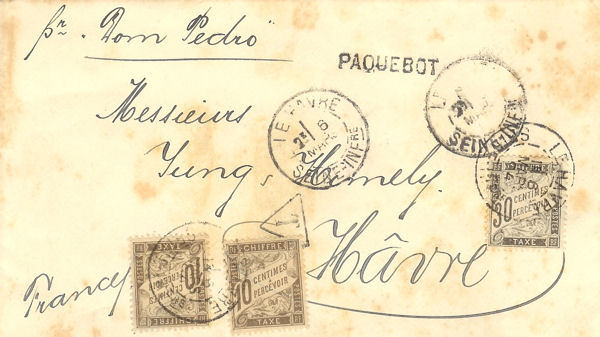
This envelope, posted at Montevideo on the 1st February 1894, received a paquebot cancel at Le Havre on the 6th March and is probably one of the earliest known dates.
While both of these paquebot marks (Hosking 22 & 410) were introduced by France and Great Britain as part of the new system under the guidance of the Universal Postal Union, some post offices continued to use their old "ship letter" cancels to show that an envelope had been carried on the high seas. One such post office was at Gravesend in England. Between 1852 and 1868 Gravesend had used three different "ship letter" marks but in 1894, instead of using the new omnibus paquebot mark, they commissioned a new "Gravesend Ship Letter" cancellation which was used on very rare occasions until 1931.
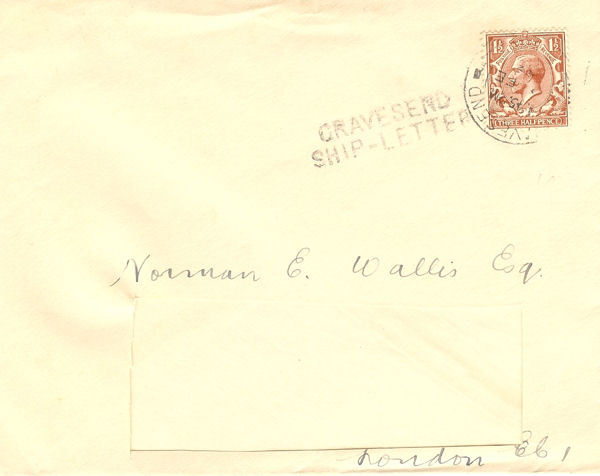
This P&O envelope dated in 1923 has the Robertson S 13 (Hosking 76DD) cancel, and while it is a late usage, it is also very rare.
One post office in the world set the record for longevity of use of its cancellation. Port Louis in Mauritius had used a metal "ship letter" mark from as early as 1850 to signify mail had been carried on the high seas and it was still in use as late as 1982 alongside their later "Paquebot" and "Navire" cancels. This is a truly amazing usage of a handstamp - a lifespan of 130 years !!
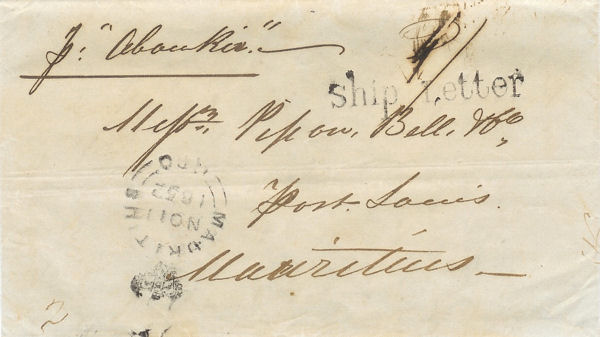
This envelope is dated 11th November 1852.
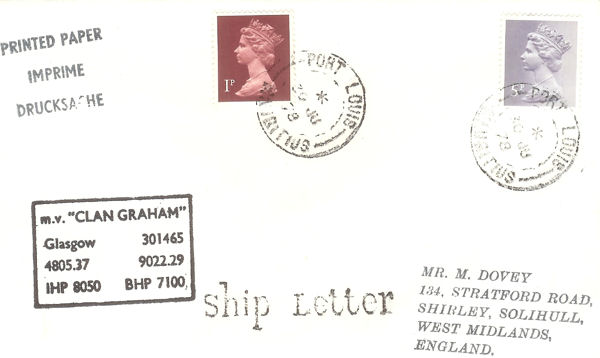
The ship letter cancel (now Hosking 2849B) is dated 30th June 1978. Subsequent examples are known for 12th December 1980 and 16th July 1982!
In 1894, at the meeting of the Universal Postal Union, it was decided that while the main language for international use should be English, it would help the French delegation if the word for this new service were to be in French - hence the name "paquebot" which was agreeable to all those at the meeting.
When the new system began in 1894, it was Great Britain and France who came out with new paquebot omnibus cancellations for many of their post offices. Other countries came up with their own marks for their ports. By 1896 there were paquebot marks for Calcutta, Port Said, Penang, and Singapore as well as those along most of the world's main shipping routes. However, many ports around the world carried on using the old ship letter marks (i.e. Sydney, Bridgetown, etc.), while ports like those in New Zealand began to use Packet Boat or Loose Letter cancels. All of these cancels have one thing in common. They were all introduced to make the movement of mail on the high seas around the world faster and easier. As this was the only method of communication at the time, it was vital that such a system would work and it did very well for well over 60 years until the advent of air travel and the demise of the regular shipping line routes around the world.
As this extract from the UPU Regulations published at Berne in 2017 demonstrates, the rules for Paquebot mail still apply.
Reference Books:
Ship Letters of the British Isles by Alan Robertson, (Only 600 copies printed and out of print),
Robertson Revisited by Colin Tabeart, (Out of print) and Robertson Revisited Supplement.
Paquebot Cancellations of the World 4th Edition, by Mike Dovey & Keith Morris, TPO & Seapost Society
and Paquebot Cancellations of the World The 2020 ADDENDA, by Mike Dovey.

